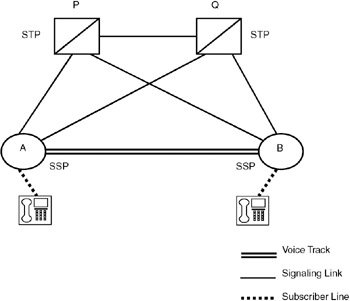26.3 CALL SETUP USING SS7
|
| < Day Day Up > |
|
26.3 CALL SETUP USING SS7
We will illustrate call setup using a simple SS7 network shown in Figure 26.2. Assume that a subscriber connected to switch A would like to make a call to a subscriber connected to switch B. The steps for call setup are as follows:
-
Switch A analyzes the dialed digits and determines that the call is meant for a subscriber of switch B.
-
Switch A selects an idle trunk between A and B and then formulates an initial address message (IAM). This message identifies the initiator switch (A), the destination switch (B), the trunk selected, the called number, and the calling number.
-
Switch A selects an A link and sends the message on the link for routing to switch B.
-
STP P receives the message, checks the routing label and, based on the label, sends it on a link (PB) to B.
-
Switch B receives the message and checks whether the called number is idle.
-
Switch B formulates the address complete message (ACM) to indicate that IAM has reached the correct destination. The ACM message contains recipient switch (A), sending switch (B) addresses, and the selected trunk number.
-
Switch B picks an A link (BQ) and sends the ACM to switch A. Simultaneously, it completes the call path in the direction toward A and sends a ringing tone over the trunk toward A and also a ring on the line of the called subscriber.
-
STP Q receives the message and, based on the routing label, sends the message to switch A.
-
Switch A receives the ACM and then connects the calling subscriber to the selected trunk in the backward direction so that the caller can hear the ringing sent by B.
-
When the called party picks up the phone, switch B formulates an answer message (ANM) that identifies the recipient switch (A), originator switch (B), and selected trunk.
-
Switch B uses the same A link it used to transmit the ACM and sends the ANM. By this time, the trunk is connected to the called party in both directions for conversation.
-
STP Q forwards the ANM to switch A.
-
Switch A ensures that the calling subscriber is connected to the trunk in both directions for the conversation.
-
If the calling subscriber goes on hook, switch A will generate a release (REL) message to switch B.
-
STP P receives the message and forwards it to switch B.
-
Switch B receives the REL message, disconnects trunks, returns the trunk to idle state, and generates a release complete (RLC) message addressed to A. RLC identifies the trunk used for the call.
-
On receiving the RLC, switch A makes the identified trunk idle.

Figure 26.2: Call setup using SS7.
For call setup using SS7, a series of packets is exchanged between the switches through the STPs using high-speed datalinks. Because the voice trunks do not carry any signaling information, they will be optimally utilized.
Because of the high-speed datalinks, call setup and disconnection are very fast.
|
| < Day Day Up > |
|
EAN: 2147483647
Pages: 313